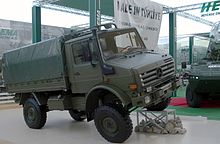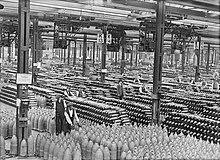Arms industry

| Part of a series on |
| War (outline) |
|---|
 |
Thearms industry,also known as thedefence (or defense) industry,military industry,or thearms trade,is a globalindustrywhichmanufacturesand sellsweaponsand othermilitary technologyto a variety of customers, including thearmed forcesofstatesand civilian individuals and organizations. Products of the arms industry includeweapons,munitions,weapons platforms,communications systemsand other electronics, and related equipment. The arms industry also provides defense-related services, such as logistical and operational support.
As a matter of policy, many governments ofindustrialized countriesmaintain or support a network of organizations, facilities, and resources to produce weapons and equipment for their military forces (and sometimes those of other countries). This is often referred to as adefense industrial base.Entities involved in arms production for military purposes vary widely, and includeprivate sectorcommercial firms,state-owned enterprisesandpublic sectororganizations, and scientific and academic institutions.[1]Such entities perform a wide variety of functions, includingresearch and development,engineering,production, and servicing ofmilitarymaterial, equipment, and facilities. The weapons they produce are often made, maintained, and stored inarsenals.
In 2024, theStockholm International Peace Research Institute(SIPRI) estimated global military expenditure at $2.443 trillion, the highest level ever recorded by SIPRI and the steepest year-on-year increase since 2009.[2]SIPRI further found that the combined revenues of the top 100 largest defense companies totaled $597 billion in 2022, with the five largest companies by revenue beingLockheed Martin,RTX,Northrop Grumman,Boeing,andGeneral Dynamics.[3]SIPRI's data also showed that, between 2019 and 2023, the five largest arms exporting nations were theUnited States,France,Russia,ChinaandGermany(taken together, they supplied approximately 75% of the world's arms exports during this period).[4]
In some regions of the world, there is a substantial trade infirearmsfor use by individuals (where such trade is legal, commonly cited purposes include self-defense and hunting/sporting).Trade in small arms,both legal and illegal, may be associated withviolent crimeandpolitical instability.In 2017, theSmall Arms Surveyestimated that approximately one billion firearms were in global circulation; of those, 857 million (85%) were possessed by civilians, 133 million (13%) were possessed by national militaries, and 23 million (2%) belonged to law enforcement agencies. The Small Arms Survey also found that the number of firearms in circulation had increased significantly between 2006 and 2017, primarily due to increases in civilian possession.[5]
History
[edit]This section includes alist of references,related reading,orexternal links,but its sources remain unclear because it lacksinline citations.(August 2020) |
During theearly modern period,England, France, Sweden and the Netherlands became self-sufficient in arms production, with diffusion and migration of skilled workers to more peripheral countries such as Portugal and Russia.[citation needed]
The modern arms industry emerged in the second half of the nineteenth century as a product of the creation and expansion of the first largemilitary–industrialcompanies. As smaller countries (and even newly industrializing countries like Russia and Japan) could no longer produce cutting-edge military equipment with their indigenous resources and capacity, they increasingly began to contract the manufacture of military equipment, such asbattleships,artillery piecesandriflesto foreign firms.[citation needed]
In 1854, theBritish governmentawarded a contract to theElswick Ordnance Companyto supply the latest breech loading rifled artillery pieces. This galvanized the private sector into weapons production, with the surplus increasingly exported to foreign countries.William Armstrongbecame one of the first international arms dealers, selling his systems to governments across the world from Brazil to Japan.[6][non-primary source needed]In 1884, he opened a shipyard atElswickto specialize in warship production – at the time, it was the only factory in the world that could build a battleship and arm it completely.[7]The factory produced warships for many navies, including theImperial Japanese Navy.Several Armstrong cruisers played an important role in defeating the Russian fleet at theBattle of Tsushimain 1905.[citation needed]
In the American Civil War in 1861the Northhad about ten times the manufacturing capacity of theeconomy of the Confederate States of America.This advantage overthe Southincluded the ability to produce (in relatively small numbers)breech-loading riflesfor use against the muzzle-loadingrifled musketsof the South. This began the transition to industrially produced mechanized weapons such as the Gatling gun.[8]
This industrial innovation in the defense industry was adopted byPrussiain its 1864, 1866 and 1870–71 defeats of Denmark, Austria and France respectively. By this time the machine gun had begun entering arsenals. The first examples of its effectiveness were in 1899 during theBoer Warand in 1905 during theRusso-Japanese War.However, Germany led the innovation of weapons and this advantage in theweapons of World War Inearly defeated the allies.[citation needed]

In 1885, France decided to capitalize on this increasingly lucrative trade and repealed its ban on weapon exports. The regulatory framework for the period up to theFirst World Warwas characterized by alaissez-fairepolicy that placed little obstruction in the way of weapons exports. Due to the carnage of World War I, arms traders began to be regarded with odium as "merchants of death" and were accused of having instigated and perpetuated the war in order to maximize their profits from arms sales. An inquiry into these allegations in Britain failed to find evidence to support them. However, the sea change in attitude about war more generally meant that governments began to control and regulate the trade themselves.[citation needed]
The volume of the arms trade greatly increased during the 20th century, and it began to be used as a political tool, especially during theCold Warwhere the United States and the USSR supplied weapons to their proxies across the world, particularlythird world countries(seeNixon Doctrine).[9]
Sectors
[edit]Land-based weapon
[edit]
This category includes everything fromlight armstoheavy artillery,and the majority of producers are small. Many are located in third world countries. International trade inhandguns,machine guns,tanks,armored personnel carriers,and other relatively inexpensive weapons is substantial. There is relatively little regulation at the international level, and as a result, many weapons fall into the hands of organized crime, rebel forces, terrorists, or regimes under sanctions.[10]
Small arms
[edit]
TheControl Arms Campaign,founded byAmnesty International,Oxfam,and theInternational Action Network on Small Arms,estimated in 2003 that there are over 639 million small arms in circulation, and that over 1,135 companies based in more than 98 countries manufacture small arms as well as their various components and ammunition.[11]
Aerospace systems
[edit]Encompassing military aircraft (both land-based andnaval aviation), conventional missiles, andmilitary satellites,this is the most technologically advanced sector of the market. It is also the least competitive from an economic standpoint, with a handful of companies dominating the entire market. The top clients and major producers are virtually all located in thewestern worldand Russia, with the United States easily in the first place. Prominent aerospace firms includeRolls-Royce,BAE Systems,Saab AB,Dassault Aviation,Sukhoi,Mikoyan,EADS,Leonardo,Thales Group,Lockheed Martin,Northrop Grumman,RTX Corporation,andBoeing.There are also severalmultinationalconsortia mostly involved in the manufacturing offighter jets,such as theEurofighter.The largest military contract in history, signed in October 2001, involved the development of theJoint Strike Fighter.[10]
Naval systems
[edit]Several of the world'sgreat powersmaintain substantialnaval forcesto provide a global presence, with the largest nations possessingaircraft carriers,nuclear submarinesand advancedanti-air defense systems.The vast majority of military ships are conventionally powered, but some arenuclear-powered.There is also a large global market in second-hand naval vessels, generally purchased bydeveloping countriesfromWesterngovernments.[10]
Cybersecurity
[edit]The cybersecurity industry is expected to be of increasing importance to defense, intelligence and homeland security agencies.[12][13][better source needed]
International arms transfers
[edit]Over time
[edit]2010–2014
[edit]
According to research instituteSIPRI,the volume of international transfers of major weapons in 2010–14 was 16 percent higher than in 2005–2009. The five biggest exporters in 2010–2014 were the United States, Russia, China, Germany and France, and the five biggest importers were India, Saudi Arabia, China, the United Arab Emirates and Pakistan. The flow of arms to the Middle East increased by 87 percent between 2009–13 and 2014–18, while there was a decrease in flows to all other regions: Africa, the Americas, Asia and Oceania, and Europe.[15]
2014–2018
[edit]SIPRI has identified 67 countries as exporters of major weapons in 2014–18. The top 5 exporters during the period were responsible for 75 percent of all arms exports. The composition of the five largest exporters of arms changed between 2014 and 2018 remained unchanged compared to 2009–13, although their combined total exports of major arms were 10 percent higher. In 2014–18, significant increases in arms exports from the US, France and Germany were seen, while Chinese exports rose marginally and Russian exports decreased.[15]
In 2014–18, 155 countries (about three-quarters of all countries) imported major weapons. The top 5 recipients accounted for 33 percent of the total arms imports during the period. The top five arms importers – Saudi Arabia, India, Egypt, Australia and Algeria – accounted for 35 percent of total arms imports in 2014–18. Of these, Saudi Arabia and India were among the top five importers in both 2009–13 and 2014–18.
In 2014–18, the volume of major arms international transfers was 7.8 percent higher than in 2009–13 and 23 percent than that in 2004–08. The largest arms importer was Saudi Arabia, importing arms primarily from the United States, United Kingdom and France. Between 2009–13 and 2014–18, the flow of arms to the Middle East increased by 87 percent. Also including India, Egypt, Australia and Algeria, the top five importers received 35 percent of the total arms imports, during 2014–18. The five largest exporters were the United States, Russia, France, Germany and China.[15]
Post-2018
[edit]The2022 Russian invasion of Ukrainechanged theNational Shooting Sports Foundationmembers ability to obtain an export license from taking a month to taking just four days.[16]This was due to theUnited States Department of Commerceand agencies associated withITARexpediting weapons shipments to Ukraine.[17]In addition, the time it took to obtain apermitto buy a firearm in Ukraine also decreased from a few months to a few days.[18]
World's largest arms exporters
[edit]

Figures are SIPRI Trend Indicator Values (TIVs) expressed in millions. These numbers may not represent real financial flows as prices for the underlying arms can be as low as zero in the case of military aid. The following are estimates fromStockholm International Peace Research Institute.[20]
| 2023 Rank |
Supplier | Arms Exp (in million TIV) |
|---|---|---|
| 1 | 11,287 | |
| 2 | 3,287 | |
| 3 | 2,432 | |
| 4 | 2,012 | |
| 5 | 1,437 | |
| 6 | 1,269 | |
| 7 | 1,204 | |
| 8 | 1,159 | |
| 9 | 940 | |
| 10 | 621 |

Overall global arms exports rose of about 6 per-cent in the last 5 years compared to the period 2010–2014 and increased by 20 per-cent since 2005–2009.[21]
Rankings for exporters below a billion dollars are less meaningful, as they can be swayed by single contracts. A much more accurate picture of export volume, free from yearly fluctuations, is presented by 5-year moving averages.
Next to SIPRI, there are several other sources that provide data on international transfers of arms. These include national reports by national governments about arms exports, the UN register on conventional arms, and an annual publication by theU.S. Congressional Research Servicethat includes data on arms exports to developing countries as compiled byU.S. intelligenceagencies. Due to the different methodologies and definitions used different sources often provide significantly different data.
World's largest arms exporters since 1950
[edit]SIPRI uses the "trend-indicator values" (TIV). These are based on the known unit production costs of weapons and represent the transfer of military resources rather than the financial value of the transfer.[22]
| 1950–2023 Rank |
Supplier | Arms Exp (in billion TIV) |
|---|---|---|
| 1 | 741,384 | |
| 2 | 451,317 | |
| 3 | 155,994 | |
| 4 | 145,889 | |
| 5 | 139,022 | |
| 6 | 93,626 | |
| 7 | 63,831 | |
| 8 | 38,557 | |
| 9 | 31,211 | |
| 10 | 25,987 |
World's largest arms importers
[edit]Units are in Trend Indicator Values expressed as millions ofU.S. dollarsat 1990s prices. These numbers may not represent real financial flows as prices for the underlying arms can be as low as zero in the case of military aid.[23]
| 2023 Rank |
Recipient | Arms Imp (in million TIV) |
|---|---|---|
| 1 | 4,012 | |
| 2 | 2,129 | |
| 3 | 1,805 | |
| 4 | 1,428 | |
| 5 | 1,374 | |
| 6 | 1,315 | |
| 7 | 1,130 | |
| 8 | 1,103 | |
| 9 | 936 | |
| 10 | 902 |
Arms import rankings fluctuate heavily as countries enter and exit wars. Export data tend to be less volatile as exporters tend to be more technologically advanced and have stable production flows. 5-year moving averages present a much more accurate picture of import volume, free from yearly fluctuations.
List of major weapon manufacturers
[edit]This is a list of the world's largest arms manufacturers and other military service companies who profit the most from thewar economy,their origin is shown as well. The information is based on a list published by theStockholm International Peace Research Institutefor 2022.[24]
| 2022 Rank | Company name | Defense Revenue (US$ billions) |
% of Total Revenue from Defense |
|---|---|---|---|
| 1 | 59.39 | 90 | |
| 2 | 39.57 | 59 | |
| 3 | 32.30 | 88 | |
| 4 | 29.30 | 44 | |
| 5 | 28.32 | 72 | |
| 6 | 26.90 | 97 | |
| 7 | 22.06 | 27 | |
| 8 | 20.62 | 25 | |
| 9 | 19.56 | 44 | |
| 10 | 16.81 | 55 | |
| 11 | 15.08 | 27 | |
| 12 | 12.63 | 74 | |
| 13 | 12.47 | 83 | |
| 14 | 12.09 | 20 | |
| 15 | 11.77 | 32 |
Arms control
[edit]Arms control refers to international restrictions upon the development, production, stockpiling, proliferation and usage of small arms, conventional weapons, andweapons of mass destruction.[25]It is typically exercised through the use ofdiplomacy,which seeks to persuadegovernmentsto accept such limitations through agreements andtreaties,although it may also be forced upon non-consenting governments.
Notable international arms control treaties
[edit]
- Geneva Protocolon chemical and biological weapons, 1925
- Outer Space Treaty,signed and entered into force 1967
- Biological Weapons Convention,signed 1972, entered into force 1975
- Missile Technology Control Regime(MTCR), 1987
- Chemical Weapons Convention,signed 1993, entered into force 1997
- Ottawa Treatyon anti-personnel land mines, signed 1997, entered into force 1999
- New START Treaty,signed by Russia and the United States in April 2010, entered into force in February 2011
- Arms Trade Treaty,concluded in 2013, entered into force on 24 December 2014.[26]
See also
[edit]References
[edit]- ^Nicastro, Luke.The U.S. Defense Industrial Base: Background and Issues for Congress.Congressional Research Service. October 12, 2023.https://crsreports.congress.gov/product/pdf/R/R47751
- ^"Global military spending surges amid war, rising tensions and insecurity | SIPRI".sipri.org.April 22, 2024.RetrievedAugust 21,2024.
- ^Liang, Xiao; Scarazzato, Lorenzo; Béraud-Sudreau, Lucie; Tian, Nan; Lopes Da Silva, Diego; Sild, Eero Kristjan (December 2023)."The SIPRI Top 100 Arms-producing and Military Services Companies, 2022".SIPRI.doi:10.55163/UJNP6171.
- ^Trends in International Arms Transfers, 2023(Report). SIPRI. March 2024.
- ^"Global Firearms Holdings".smallarmssurvey.org.RetrievedAugust 21,2024.
- ^"William Armstrong | About the Man".williamarmstrong.info.Archivedfrom the original on September 30, 2019.RetrievedJuly 6,2021.
- ^Dougan, David (1970).The Great Gun-Maker: The Story of Lord Armstrong.Sandhill PressLtd.ISBN0-946098-23-9.
- ^"Defense Industries – Military History".Oxford Bibliographies.Archivedfrom the original on December 7, 2019.RetrievedNovember 3,2015.
- ^Stohl, Rachel; Grillot, Suzette (2013).The International Arms Trade.Wiley Press.ISBN9780745654188.Archivedfrom the original on January 21, 2023.RetrievedFebruary 7,2013.
- ^abc"International Defense Industry".Foreign Policy Association(Newsletter). Archived fromthe originalon July 26, 2011.RetrievedMay 20,2007.
- ^Debbie Hillier; Brian Wood (2003)."Shattered Lives – the case for tough international arms control"(PDF).Control Arms Campaign.p. 19. Archived fromthe original(PDF)on July 23, 2011.RetrievedMarch 28,2009.
- ^"The defence industry – a changing game?".NATO Review.Archived fromthe originalon September 14, 2016.RetrievedJuly 25,2021.
- ^"Cyber security for the defence industry".Cybersecurity Review.May 5, 2015.Archivedfrom the original on December 8, 2015.RetrievedNovember 2,2015.
- ^Wezeman, Pieter D. (December 7, 2020)."Arms production".SIPRI.Archivedfrom the original on December 17, 2014.RetrievedJuly 25,2021.
- ^abcFleurant, Aude; Wezeman, Pieter D.; Wezeman, Siemon T.; Tian, Nan; Kuimova, Alexandra (March 2019)."TRENDS IN INTERNATIONAL ARMS TRANSFERS, 2018"(PDF).sipri.org.Archived(PDF)from the original on March 15, 2019.RetrievedJuly 25,2021.
- ^Goodman, Joshua (March 18, 2022)."American gunmakers ramp up efforts to help Ukrainians fight back against Putin".Associated Press.Archivedfrom the original on March 19, 2022.RetrievedMarch 22,2022– via Fortune.
- ^"U.S. Gunmakers' efforts to get weapons to Ukraine often stifled by red tape".Newsweek.March 18, 2022.Archivedfrom the original on March 24, 2022.RetrievedMarch 24,2022.
- ^Marshall, Andrew R. c. (March 2022)."Ukrainians rush to buy rifles, shotguns as police relax rules".Reuters.Archivedfrom the original on March 22, 2022.RetrievedMarch 22,2022.
- ^"US Arms Exports Hit Record High in Fiscal 2023".Voice of America News.January 29, 2024.
- ^"SIPRI Arms Transfers Database".SIPRI.Archivedfrom the original on December 19, 2018.RetrievedJune 14,2022.
- ^"The 5 major arms exporters in the world".International Insider.March 13, 2020. Archived fromthe originalon April 20, 2020.RetrievedMarch 13,2020.
- ^"SIPRI Arms Transfers Database".SIPRI.February 12, 2024.
- ^"SIPRI Arms Transfers Database".SIPRI.Archivedfrom the original on March 16, 2018.RetrievedOctober 15,2019.
- ^"The SIPRI Top 100 arms-producing and military services companies in the world, 2022".SIPRI.RetrievedFebruary 15,2024.
- ^Kolodkin, Barry."What Is Arms Control?".About.The New York Times Company. Archived fromthe original(Article)on September 3, 2016.RetrievedMay 13,2012.
- ^Delgado, Andrea (February 23, 2015)."Explainer: what is the Arms Trade Treaty?".The Conversation.Archivedfrom the original on April 29, 2021.RetrievedJuly 25,2021.
